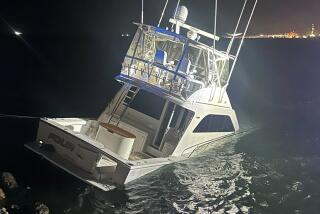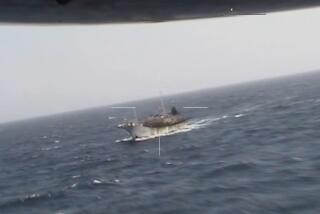Fishing Barge: A Place to Catch, Savor the Sea
- Share via
On a barge anchored in the ocean, far enough from the smoggy shore, the fishing proceeds as unhurried as the day itself.
The red deck, flooded with sun, holds people with poles and tackle boxes. They seem peaceful and content as they wait for bites which may never come.
The barge, the Annie B, had been reached in 12 minutes via a boat from Belmont Pier. It provides two views: the Long Beach coastline and the federal breakwater. The fishermen ignore both, eyeing instead the water’s murky green surface, under which the fish are deciding whether to take the bait.
From the accumulation on the deck, a lot of fish are making bad decisions.
Burlap bags are filling. Inside them, unseen mackerel put up a final fight for life. Then the bags are still.
Dip for Wriggling Anchovies
Bait fish, provided as part of the $13 cost of the trip here, swim in tanks. The fishermen make frequent trips to the tanks, dipping with their fingers for wriggling anchovies that unknowingly await hooks and then the mouths of fish bigger than they.
Among the rod wielders are boys and girls with baseball caps topping their freckled faces. They had come with grandfathers, who savor the sea with a beer and cigar.
“Gosh dang, I had something,” says one of the Huck Finns, Donnie Carter, 8, of Downey. He winds his reel again and a small fish is yanked into the air, spinning in the sun like a silver top before falling to the deck. Donnie reaches erratically for it as one would for a firefly. Finally, he grasps its flopping body, slippery as soap, from under a picnic table and pitches it back into the ocean.
Catching a fish, Donnie says, is a thrill but not one comparable to hitting a home run in Little League. “I get a free ball if I hit a home run,” he says.
His grandfather, Glen Larson, 65, of Downey, is trying to fish himself, between the constant calls of, “Look, grandpa.”
“I’ve never been out here on a bad day yet,” Larson says. “Can’t find a better place to bring the kids.”
Walter Carter, 52, of Bellflower, unrelated to Donnie, is having the success you would expect from a man who fishes every day. At midmorning, his bucket is full of cod and mackerel, the ones on top still opening and closing their mouths although their eyes are black, unreflecting holes.
“I use them for catfish bait,” Carter says, puffing a pipe. He’ll take them home, put garlic salt and brown sugar on them and two aspirins in them and take them to the Salton Sea on a weekend quest for catfish. “They love that garlic; the sugar makes them tough so they can’t get off the hook, and a guy told me a long time ago that aspirin will draw the fish,” Carter explains.
According to barge master Richard Brown, about 180 people come here daily to fish. Brown, 59, has a large mass of hair and an unmanaged beard, both gray. His jeans are tucked into rubber boots. His shirt sleeves are rolled above the elbow and reveal tattoos--a little sailor near the wrist, a naked lady along the forearm. “Just like all sailors,” said Brown, who spent 30 years in the Navy.
Brown assists first-time fishermen, cleans fish, tells fish stories and fishes himself. He reeled in a halibut and slapped the flat fish down to be measured. It was 19 inches long so Brown tossed it overboard. “They have to be 22 inches or longer (to keep) or it’s a $56 fine,” he said. “But that proves they’re down there.”
But where? Derrick Allen, 20, whose sweat shirt identified him as a Fresno State football player, had little luck. “I’ll never come on this thing again,” he said. “Fishing is real exciting--if you succeed. I’m not that great of a fisherman.”
He got on the next boat back to the pier.
The fishermen come and go, but Tom Randolph lives here with his wife Frankie, who is cooking cheeseburgers in the galley, and their deckhand daughter Geneva.
“It’s better here than in that crowded shore,” said Randolph, the barge’s hefty night watchman. “None of us like that city life. You have dinner, watch the sunset and there’s no people burning rubber up and down a street. And you don’t have to listen to neighbors arguing.”
A passing boat can cause the 50-yard-long barge to bob, but the movement is too weak to cause seasickness.
“A guy can bring his family out here,” Randolph said. “It’s not like sportfishing, where it gets rough and everybody’s getting sick. Here the wives can fish and then go in (the galley) and watch their programs on TV.”
Watched by a pelican, J. C. Winding of Los Angeles rests his elbows on the rail and works two lines.
“Fishing was more fun 15 to 20 years ago,” he says. “The water was cleaner, the bait bigger and more plentiful, and the fish bigger. You need big bait to catch big fish.”
From a radio somebody brought, Whitney Houston’s voice barges in on the serenity. Deep in concentration, the fishermen don’t complain.
But Winding complains when another fisherman, forced down several spaces by a running fish, tangles his line with Winding’s.
“Some need to stay home and fish in a bathtub,” Winding says. “You play the fish, you don’t let the fish play you.”
He goes to the tank, looking for bigger bait.
Suddenly, one of his unattended rods is yanked up the side of the railing by an unseen force. Winding runs to grab it, managing to keep himself from going overboard.
It is a big bonito, and with it comes a rush of excitement. Winding lands it quickly; others stop to watch as it thumps the deck, desperate for the water it will never have again.
Winding grabs it with a rag, steadies it and pulls the hook from its mouth with pliers. Without comment, he puts it in a burlap sack.
Blood oozes. Excitement ebbs. Peace returns.
More to Read
Sign up for Essential California
The most important California stories and recommendations in your inbox every morning.
You may occasionally receive promotional content from the Los Angeles Times.










